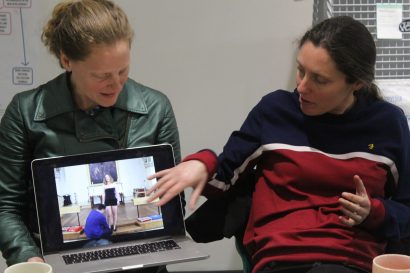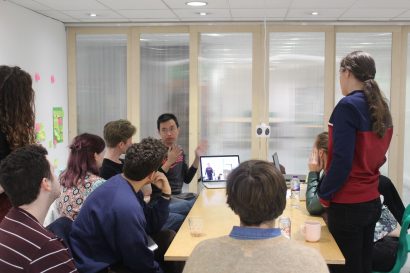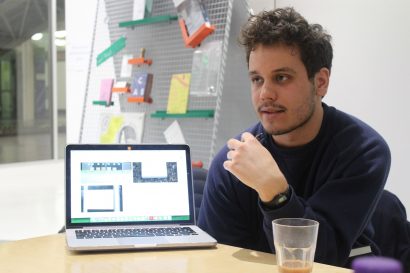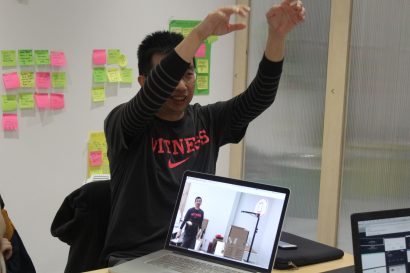- Written by Louise Ashcroft
- Feedback Sessions
Louise Ashcroft // Artists’ Lunchtime Feedback
Artists Feedback, a session led by Louise Ashcroft at Turf Projects (March 2019).
Artists Presenting:
Joe Gray + Josh Nixon
Sam Wills – www.samwillsart.com
George Wong – georgewongyungchoon.com
Natalia Kieniewiez – voiceofthedakini.wordpress.com
Emma Jude
Laura Adamson
Also in attendance:
Agata Nowak
Seonagh Murray
Michael Balamwezi
Holly Graham
Joe Gray + Josh Nixon
Two filmmakers, Joe Gray + Josh Nixon enter the space having stumbled across Turf Projects. One local, one never having been to CR0 before, both currently based in Newcastle. Their film will try to suck in the ectoplasm of Croydon as it gestates into a future by means of giant concrete core, fast-tracked planning application and hoardings of architects’ visions. It is a sci-fi time, and their film (which is not yet shot) will tap into the otherworldly qualities of architecture old and new. Narratives will be evoked through imagery alone – they want no words to pin them down. In Maggie Nelson’s book Argonauts she questions the limits of language, in a debate with her partner who is suspicious of society’s trust in linguistic articulation. These filmmakers might side with this suspicion, as they seek to impart physicality and aesthetic more than describe local politics. Articulate is such a physical word – triggering imagery of joints and seams – for a phenomenon so imaginary as language. I am reminded of testimonies of revellers recounting the moon on the night Abraham Lincoln’s son died (in the fact-based fiction Lincoln In the Bardo by George Saunders which I am currently reading). The night in question is reported as moonlit, moonless, red mooned, yellow, full-mooned and a thin crescent, by various contradictory witnesses. Who should we believe? Can they all be right? Is contradiction more trustworthy than consensus? How do we bear witness in a way that acknowledges the limits of language and the limits of witnessing? Perhaps that’s what Joe and Josh are trying to do here. We talk about how language might be opened up, to include nonsense or poetics – instead of the narrower understanding of its conventional role within traditional documentary-making. I find myself returning to the question of whether nonsense can be critical, or political, and I might have spouted something about how confusion catalyses the necessity for taking personal responsibility for one’s interpretation and position instead of passively following a didactic passage authored by someone else. Advertising has a fixed aim, but art has an aim which is curved, or constantly shifting. The word viewer is perhaps the wrong one, as it’s so detached; so what do the filmmakers want from their film and who is it for? It’s early days, but their reluctance to directly involve members of the public or voiceovers of their own textual musings or chats is clear. The BBC documentary series The Secret History of our Streets have a strong critique of power running through them, with the Deptford one almost like a ‘who dunnit’ perpetuating a conspiracy theory (probably a true one) that the council had no grounds for post-war slum clearance. There are so many ways to make a documentary, and sometimes the filmmaker’s persona is involved. From the strangely calm eccentricity of Louis Theroux or girl-next-door extreme anthropologist Stacey Dooley; it is a game of trust, to be let inside and yet retain a certain exteriority. The documentary maker must occupy the boundary between insider and outsider. Joe and Josh have a unique position in relation to the place, because they have both outsider eyes and insider knowledge, as one is local and one isn’t. Looking is always deeply political, and never neutral (even when it pretends to be in order to seem authoritative) and there is a power relation implicit in every gaze. Mary Louise Pratt’s book Imperial Eyes explores how travel writing has produced ‘the rest of the world’ for European readerships and the enormous significance of travel writing as an ideological apparatus of Empire. These politics of the gaze might also apply to a film about Croydon, and this town’s complex alloy of local, global, glocal cultures, in which imperialism takes the form of capitalism (Westfield, fast food chains and luxury apartments). It would be easy to make a clichéd film about gentrification, but they are hoping to nurture ambiguity during the image-capturing process in order to complicate such familiar narratives. Suggestions of filming at twilight or experimenting with camera angles and ways of capturing or making sound are also aired. Perhaps they want it to feel strange, to ‘other’ the local in order to access it at arms length, to transform it into an alien landscape so that they can conquer it like spacemen landing for the first time. And how does this relate to Guy Debord’s idea of the ‘spectacle‘, an image which replaces its referent in a violently reductive way? Perhaps to make a disorientating film, which is neither daytime or night time, which is both familiar and strange, they are hoping to make a film about Croydon in flux by becoming that flux rather than representing it. If Josh and Joe were making a film about the sea they’d throw the camera into the sea rather than filming from the shore.
Sam Wills www.samwillsart.com
An inside-out readymade. Don’t take the found object into the gallery, take the gallery (its mind set) to the world. That’s the logic of Sam’s piece. This work makes ordinary features of the park bizarrely significant, by using them to tell the park’s (real) extraordinary history; a history of public hangings and Chartist revolution. I am reminded of the laminated a4 printout at The Freud Museum which is placed on top of a couch and reads ‘please do not sit on the couch, Sigmund Freud died on this couch’; like wet paint signs it is more tempting than prohibitive. Sam’s project is a monument-machine, which does away with the aloofness of traditional state-authored monoliths and turns the drinking fountain into a visceral reference to the bodies of the victims of corporeal punishment. Is it distasteful, and does it need to be in order to get beyond statistic? Perhaps monuments should get blood on passers by, in order to keep the wounds unpicked as this is the only way to keep history from repeating itself? Playfully appropriating the council’s banal parody of democracy which takes the form of interactive boxes which allow locals to choose the colours of tiles on a new station façade, and giving them a story with political resonance is an elegant hack which critiques the emptiness of any project that pretends to engage with community without ever really connecting or meaning anything (and this is something that artists trying to tick funding boxes are not immune to). The project begs us to reflect deeper on what it means for space to be public, and whose voices should be present there, as well as who is giving those voices authorship and for what purpose. Mostly, the pieces make us question the authority of signage and text in public space, as well as the authority of state apparatus in general. What is the artist trying to say? He doesn’t let us off the hook that easily, we have to come up with the answers ourselves, or rather more questions. A state-endorsed plaque might even say something similar, the signs manage to ‘pass’ right until their last sentences where they lose their formality and start to feel hyperbolic or colloquial so we start to doubt them, as well as the grass, trees, walls, benches and passersby. The artist makes us double-take at what we might describe as reality, but which is in fact highly subjective experience signposted towards contexts that those in control have deemed worthy of reflection. The works are at their best when their use of description makes the stories they’re alluding to more visceral and personal than the faux-neutrality of most public plaques. I think they could go even more in that direction, more specific and more spurious, yet true – what did it feel like for a particular victim of execution, did anything strange happen? Should only major events be chronicled or might the uneventful, unheard, non-canonical ones be signposted too?
George Wong georgewongyungchoon.com
A basketball hoop with a cardboard box below is shown on screen. Each time you score, the ball lands in the box and a different object comes out as if by magic – the ball shapeshifting. What do sport and magic have in common? The ritual. The impossibility. Stretching physics. Are there any Olympians with an interest in conjuring? Perhaps they are closer than we think. People celebrate sportspeople as heroes but are more likely baffled by artists, because you can’t measure art. In George’s video, a man with the word ‘witness’ on his Nike branded Tshirt (it’s George himself) simulates throwing a basketball through a hoop in slow mo. Deliberately missing the shot the first time, for realism, his slo-mo play-through shows us how it works, as though pitching for a kickstarter so that we might chip in and make this impossible tech real. Second time he shoots, it’s through the hoop and into a cardboard box directly below. The box spits out the ball again, except this time it’s a balloon. He shoots the balloon in the hoop and next time it’s a frisbee, and next the frisbee becomes a little white cube, and then something else. If writer and infinity-fan Jorge Luis Borges was still alive he’d be busy inventing this very machine. It’s addictive to watch. George mixes the rational with the absurd. His basket-hoop box transforms whatever you throw into it, as magically as your goods arrive when you hit the Amazon prime button. The work speaks of the seeming magic of global logistics and the processes of competition that we go through in order to access such consumer power. We are completely distanced from the objects that arrive in boxes on doorsteps… explain your internet shopping to a Viking and they’ll worship it like a God. Like machines used to train dogs or monkeys with treats, the dopamine hit of this novelty basketball game makes the player keep coming back for more. An allegory for capitalism? A philosophical exploration of objecthood and how everything is the same as everything else? An improbable physics experiment? The deadpan way in which in the artist talks us through this makeshift prototype for the machine is maybe better than if he made a perfectly slick final machine, because it’s his suspension of disbelief that is the most interesting subject of the work. It’s like a magic trick that gets better when you explain the magic away, or a joke that gets better when you dissect it. Consumerism is fuelled by this belief in shapeshifting, or transubstantiation. We know that the player’s Nike Tshirt is just like any other tshirt, but with a different symbol on it, and yet it has a brand identity, an ethos, an aura. We know it’s just the same as any tshirt but we want to believe in something so this swoosh (an approximation of the wings of Nike the ancient Greek deity) is all we have to hold onto. The magical basketball work perhaps revels in the illusion of variety that advanced capitalism gives us, and yet also in the comforting mundanity of what it promises – the world doesn’t change each time he shoots a hoop, but a ball turns into a balloon which then turns into a frisbee. I expect Google will commission this machine pretty soon, a device to reintroduce the illusion of spontaneity and unpredictability in an increasingly regulated, algorithmically controlled world.

Natalia Kieniewiez voiceofthedakini.wordpress.com
An opera singer (Natalia herself) choruses a mournful song, apparently unaware that audience members are dressing her with garments from a pile of clothes. The clothes are glitzy – just what we’d expect of costume for an opera diva. The piece is humorously titled ‘dress the diva’. Like the impossible basketball machine we just discussed, dress the diva challenges us to a game. In the game the audience must transgress the boundary between the performer’s personal space and the distance that would usually separate them from her. At times this might be awkward, at others it becomes anarchically playful. Unlike Yoko Ono or Marina Abramovich inviting the viewer to cut clothes off or interact with the performers body using a selection of dangerous props, Dress the Diva adds the extra layer of authority that is opera – an art form synonymous with tradition, class and opulence. The act of dressing the diva is a transgression of etiquette, an attempt to destabilise the spectacle, like watching the queen take a piss. ‘Does the queen fart?’ is the second most common google search about our sovereign, the first being ‘does the queen eat swans?’. A similar muddling of mythology and base materialism is used in Dress the Diva in order to dishevel the pristine image of the opera singer, and yet this material antagonism only elevates her perfection by reinserting her in the repetitious reality of the everyday life so familiar to us all. Like the dishevelled diva, watching the queen piss or eat a swan doesn’t overthrow her power, it revives it, just the way a self-cannibalising social media overshare or a humble brag does. Natalia is reclaiming vulnerability as agency, and then wondering if that’s problematic or not. ‘She stoops to conquer’ is the title of the Oliver Goldsmith play which mocked the simplistic morality tales of sentimental comedies in the 18th century (a period which also saw the explosion of opera across Europe) by complicating it, and Dress the Diva stoops to conquer too. By making herself vulnerable, the diva humanises herself, and this fuels her iconic status – like brands who say ‘ooops’ when they mess up. It’s something about proximity and iconography which relates to what we talked about earlier regarding Josh and Joe’s film proposal. Natalia’s diva’s performance is vocally flawless, as though she were in a parallel reality thus unable to see the worker bees adding more layers of sequined garments to her body. What happens when no more clothes will fit? Undressing the diva is a very different gesture. Natalia talks about the work in terms of her own difficulties with asking for help – something which seems at odds with the professionalism and genius ascribed to opera singers. An opera singer wailing for help is an arresting image. And yet, the powerplay between audience and diva is more complex than that, she plays with binaries and leaves us unsure who’s the helper and who’s the helped, or who’s in charge and who’s being controlled. Handle With Care, an event at Wellcome Collection which I performed as part of last year, featured works which tried to deal with the nuances of power that occur within the context of care. Comedians like Ricky Gervais (in the sitcom Derek) or Little Britain (as wheelchair user and support worker duo Lou & Andy) have tried to use humour to deal with such complexities in the past, but it always feels a bit cringey or heavy-handed. If she pushes it further, perhaps the autobiographical nature of Natalia’s piece means she can push this care dynamic much further than any fictional stereotype enacted by a comedian who has nothing personal to put on the line could ever do. Another challenge is how to get the audience to feel compelled to help in the first place – emotional criteria such as guilt, embarrassment, duty, responsibility, the desire to be liked/helpful/good can all be exploited. Song choice is key to setting the tone of the diva, and the song might change as she evolves. Perhaps an incentive could be given to audiences to encourage interaction – maybe the song responds to the clothing which is added. Not like a coin-operated automaton, a la pygmalion, much more unpredictable than that. The piece connects well with Laura Adamson’s piece on the monstrosity of hoarding, which is discussed further below.
Emma Jude
Having explored various traditional art mediums alongside her geology practice, Emma is at the stage where she has realised that she doesn’t want to represent geography using paint or pencil, but wants to use the tactics, media and strategies – the language- of geology systems in order to ask the questions she wants to ask in her art practice. In the era in which artists tend to jump between genres hungrily, often mastering crafts for specific projects, to a certain level, and then moving on, it is exciting to meet someone who has equipped themselves with specialist skills from another field and is now ripe to use them. However, Emma explains that sketching is in fact a primary means of data collection within geology, and so both art and geology have a shared tradition – if sketching is dwindling in popularity amongst artists (in favour of skills from other fields such as 3D imaging, architecture, social work etc) then maybe it’s only the geologists who will keep it alive? The difference is that the geologists seek truth through using sketches as evidence (just like Captain Cook did on his voyages to document creatures and botany on faraway lands on The Endeavour) but artists can use this method fictitiously. Is fiction a form of data collection? Can fiction or speculation get us to the truth? In the book Speculative Everything, speculative designers (is that another term for artists?) Dunne and Raby pose ‘what if’ questions that are intended to open debate and discussion about the kind of future people want (and do not want). In this case, speculation offers us a pathway to the truth beyond our own location in space and time – it allows the geologist to time travel and hypothesise. In such uncertain ecological times, Naomi Klein argues that we need new stories if we’re going to respond to ecological threat – stories are crucial ways of allowing empathetic connection with environmental statistics, emotion being something that science seeks to remove. Take the comments of Nobel scientist Tim Hunt who was made to apologise for criticising women scientists for crying or falling in love, comments which Dr Jennifer Rohn responded to in The Telegraph by arguing against the stereotype of scientists as ‘cold, calculating geeks’, explaining “I’ve had a bit of a weep, gone to the loo and washed my face, and then got back on with my job, but equally I’ve seen men sobbing over their test tubes”. It sounds like I’m portraying art in a very sentimental way, as though it makes us weep, when it can just as readily make us analyse, philosophise and calculate. We didn’t have time to expand on the differences between art and science, or what Emma might want to do with the sketches, charts and field data from her geology profession, but I’m sure this will be developed at a future Turf Projects feedback session.
Laura Adamson (Lolly)
Lolly is talking to us about a performance she did recently in which she wandered around an event space for several hours inviting the public to select or donate objects which she would tape to herself, thereby gradually becoming a monstrous sculpture-collage. He body becomes transformed by the weight and shape of each object so that she is forced to move about in unconventional ways. The work is a live piece, a video and a series of images, with the latter being much more slick and fashion-like than the more shambolic melancholy of the former. If the objects and tape were invisible, we’d see a contorted figure limp around the space begging for clutter from strangers. There is something very comical and tragic about it. It’s undoubtedly laugh-out-loud funny, but there’s a sense that there’s a futile, nihilistic frustration there – which is revealed in our conversation to be the story of the artist’s own mother, whose compulsive hoarding has had the same life-contorting effect as this benign cyborg, this Edward Scissorhands-like character, whose very process of connecting with others through cultural reliquary is what ultimately makes her more alienated, more lonely than ever. It brings to mind the way Olivia Laing described Andy Warhol in her book The Lonely City, which I am now reading because Holly Graham (who works at Turf projects and organised this feedback session) is also reading it. We probably won’t get time to talk about the book together, but there is something about reading it in parallel that feels like connecting to the mind of a peer. Lolly’s hoarding creature seeks to connect in similar ways, but becomes further and further removed from the viewers’ bodies, less able to move and speak, the more she engages with them. Having seen Lolly’s work before, I am struck that invisible disabilities and emotional states are often made physical in excessive ways in various works of hers, and I wonder if it’s useful for her to read Crip Theory by Robert McCruer which analyses the differently abled body in relation to queer theory. Whilst the objects undoubtedly ‘other’ lolly in the performance, they also display vulnerability and wear it as a carnvivalesque costume, taking ownership of it like the way Warhol eventually does of his camp gait and unconvincing wig as described in Laing’s aforementioned book on loneliness) – it’s only when he owns his outsiderish-ness that people flock to him for connection, perhaps because fallibility and disorder are the real things that unite us all. To many it might be frustrating to watch the hoarder accumulate objects until she can barely move, but to many there is a catharsis in it, and a sense that there is someone spilling their truth out on stage; offering up her loneliness so that we see ourselves in it and establish a peculiar kind of kinship.
Share:
More:


Related:


- Thu Mar 28, 2019 @ 19:00
- Led by Louise Ashcroft








